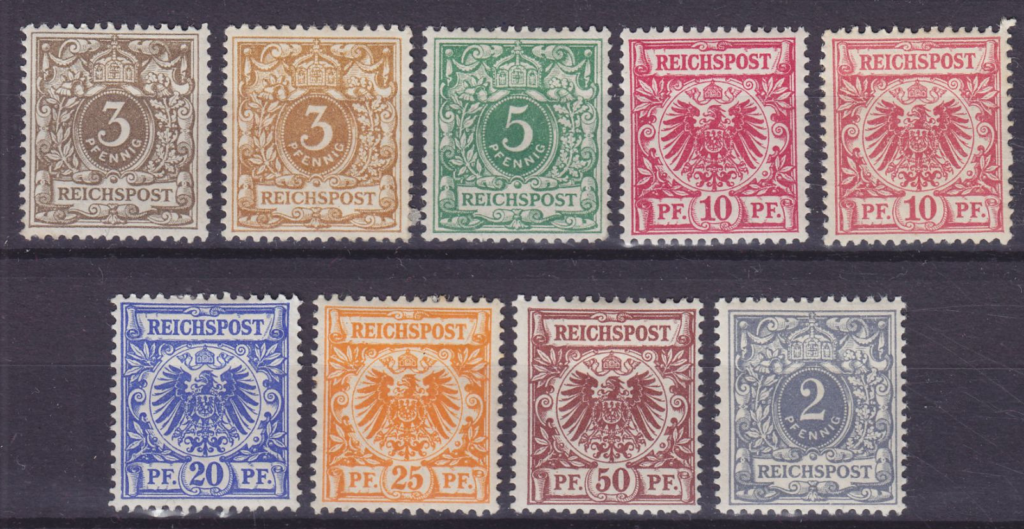The late 19th century saw the German Empire firmly establish itself as a European power under the reign of Emperor Wilhelm II, following the brief rule of Emperor Friedrich III. With the expansion of the empire, the need for an efficient postal system became paramount. The 1889–1900 stamp issues, known as the Reichspost series, played a crucial role in the postal history of Germany. These stamps, with their detailed designs and typo-graphed printing, are now highly sought after by collectors.
This article explores the history of the emperors, the evolution of Germany’s postal system, and provides a comprehensive analysis of the 1889–1900 Reichspost stamp issues, including their varieties, pricing, and notable forgeries.
Historical Context: Emperor Friedrich III and Emperor Wilhelm II
Emperor Friedrich III ruled Germany for a mere 99 days in 1888, a period often called the Year of the Three Emperors. Despite his short reign, he was known for his liberal outlook and plans for reforms. His son, Wilhelm II, ascended the throne in June 1888 and ruled until 1918. Under Wilhelm’s reign, Germany saw rapid industrialization, military expansion, and growing international ambitions, all of which necessitated a robust postal network.
The Evolution of Germany’s Postal System
During the late 19th century, Germany’s postal system transitioned from regional networks to a centralized Imperial Postal Administration (Reichspost). By the 1890s, the country had a well-developed system with an increasing volume of mail, necessitating the issuance of new definitive stamps.
The 1889–1900 Reichspost series was characterized by:
- Typo-graphed printing with intricate designs.
- Perforation of 13½×14½, allowing easy separation of stamps.
- Denominations ranging from 2 pfennig to 50 pfennig.
- Various colour variations and printing errors, making them valuable to collectors.
The 1889–1900 Reichspost Stamps: A Detailed Analysis
Below is a breakdown of the notable Reichspost issues, including their varieties and pricing.
Low-Denomination Stamps
- 2 Pfennig Slate (March 29, 1900)
- Market Price: £1.50 (unused), £1.50 (used)
- Error: ‘REIGHPOST’ instead of ‘REICHPOST’
- Market Price: £95 (unused), £225 (used)
- 3 Pfennig Grey-Brown (November 1889)
- Market Price: £5 (unused), £2.30 (used)
- Varieties:
- Imperforate Pair: £450
- Deep Brown: £100 (unused), £110 (used)
- Orange-Brown: £25 (unused), £8.75 (used)
- Bistre-Brown: £120 (unused), £5.50 (used)
Mid-Denomination Stamps
- 5 Pfennig Yellow-Green (February 1890)
- Market Price: £1.90 (unused), £1.50 (used)
- Varieties:
- Blue-Green: £4.75 (unused), £2.30 (used)
- Cedilla on ‘C’ in ‘REICHPOST’: £12.50 (unused), £65 (used)
- 10 Pfennig Rose-Carmine (October 1889)
- Market Price: £5 (unused), £5.75 (used)
- Varieties:
- Imperforate Pair: £400
- Carmine (1890 issue): £7.50 (unused), £2.40 (used)
- Stroke Through ‘T’ in ‘REICHPOST’: £130 (unused), £65 (used)
High-Denomination Stamps
- 20 Pfennig Violet-Blue (November 1889)
- Market Price: £12.50 (unused), £2.30 (used)
- Varieties:
- Dull Blue: £10 (unused), £2.75 (used)
- 25 Pfennig Orange-Yellow (March 1890)
- Market Price: £300 (unused), £12.50 (used)
- Varieties:
- Imperforate Pair: £900
- Orange Variant: £50 (unused), £3.50 (used)
- 50 Pfennig Lake-Brown (November 1889)
- Market Price: £1900 (unused), £110 (used)
- Varieties:
- Imperforate Pair: £1500
- Chocolate Variant (September 1890): £50 (unused), £2.30 (used)
Special Issues and Museum Reprints
Some stamps from this series were also produced as imperforate specimens, primarily for the Berlin Postal Museum. These include:
- 3 Pfennig in Red-Brown
- 25 Pfennig in Orange-Yellow
- 50 Pfennig in Chocolate
The market value for these imperforate reprints is estimated at £250–£350 per unused stamp.
Forgery Concerns
Due to their rarity and high value, several Reichspost issues have been forged over time. Some key warning signs include:
- Errors not originally recorded, such as misplaced lettering.
- Poor quality of typographic impressions compared to genuine issues.
- Inverted embossing (a common fake found on the 10-pfennig issue).
Conclusion
The 1889–1900 Reichspost series remains a fascinating part of German philately. These stamps not only represent a crucial period in Germany’s postal history but also hold significant collectible value due to their numerous varieties and print errors.
For collectors, knowledge of rarities, market values, and common forgeries is essential when acquiring these stamps. Whether you’re a seasoned philatelist or a history enthusiast, the stamps from Emperor Wilhelm II’s era continue to offer a captivating insight into the imperial German postal system and its evolution.
As interest in classic European stamps grows, the Reichspost issues of the late 19th century will undoubtedly remain highly prized among collectors worldwide.


